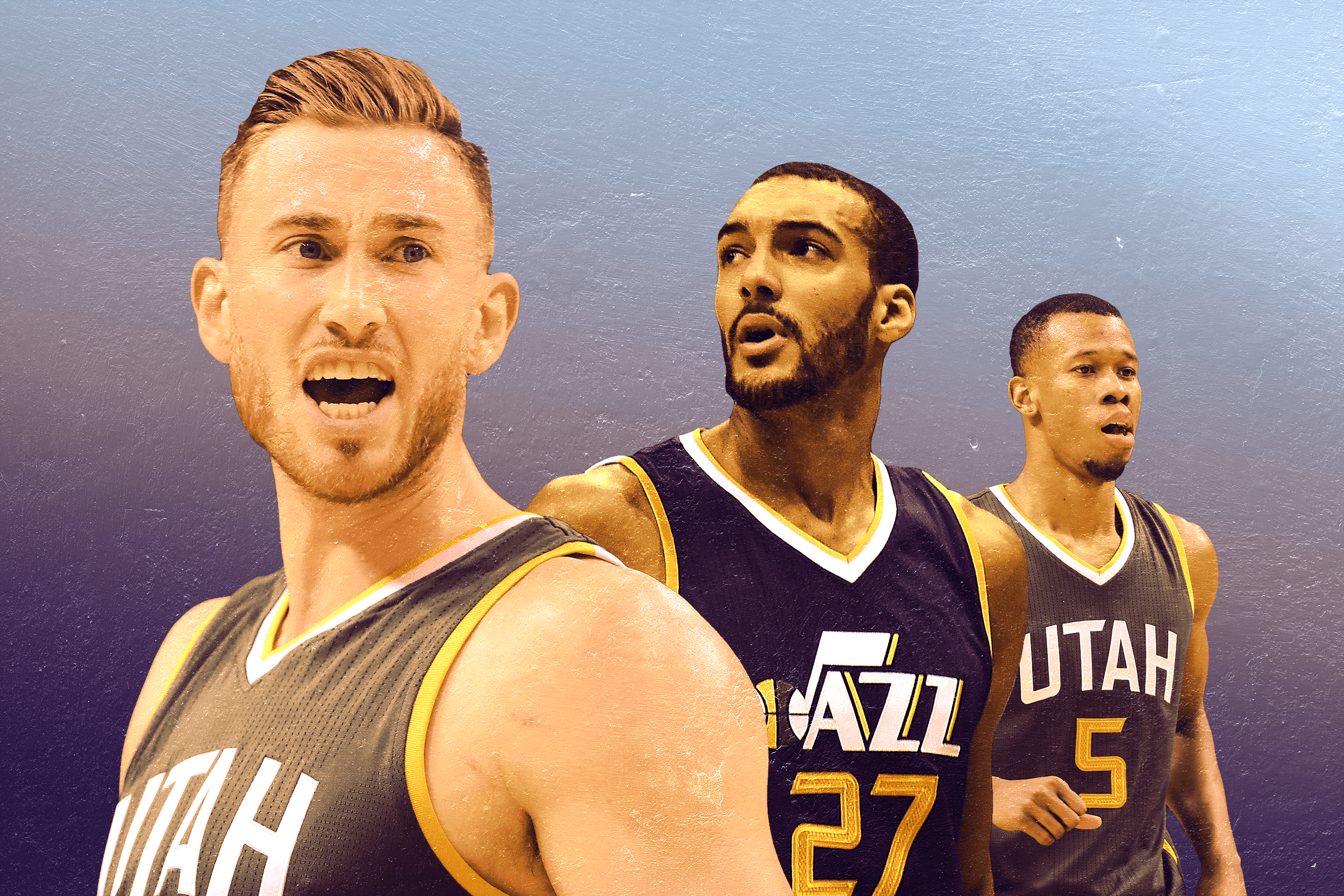
There’s still a lot we don’t know about the Utah Jazz. When they last made the playoffs in 2012, Al Jefferson and Paul Millsap were their best players, Gordon Hayward was their third option, and Derrick Favors and Alec Burks had small roles off the bench. Rudy Gobert, Rodney Hood, Dante Exum, and Joe Ingles weren’t even in the league yet. The Jazz have no postseason experience together, which is fairly unusual for a team that has won 50 games. Because they missed the playoffs in 2015 and 2016, they have never been the plucky upstart happy to win a few games in the first round. Utah has skipped a bunch of steps in the team-building process.
The crucible of a seven-game playoff series exposes a team’s underlying fault lines. It’s not just a head-to-head matchup against one of the best teams in the NBA; because coaches typically shorten their rotation and give more minutes to their best players, it’s a head-to-head matchup against the best version of one of the best teams in the NBA. Every minute of game action, and every decision a coach makes, becomes precious. Unlike in the regular season, coaches can systematically plan against their opponents and tailor their rotation to attack their weaknesses over the course of a specific series. A team can change dramatically between the beginning of a playoff series and the end. How the Jazz think about themselves, and their reputation around the league, will be shaped in large part by what happens over the next few weeks.
Utah has a lot of tough decisions to make this offseason, and it won’t have much playoff information to base them on. The comparison with the Clippers, their first-round opponent, is telling. Blake Griffin, like Gordon Hayward, was a rookie in 2010 (after sitting out the 2009–10 season due to a knee injury), and both will likely opt into free agency this summer via their early termination and player options. Griffin has been to the playoffs in each of the past six years. This is only Hayward’s second appearance. Utah’s cornerstone has said the ability to compete for championships will be the most important factor in where he signs next season, so losing a quick series to the Clippers may push him out of the door. Conversely, it would be much harder for Hayward to leave if the Jazz make it to the second round and play a competitive series against the Warriors, the presumptive title favorites.
Hayward’s departure would close Utah’s window to contend before it ever really opened. The stakes couldn’t be higher for the Jazz, which is why they are the most interesting team in the first round. Here are seven questions about the team that the playoffs will go a long way toward answering:
How Good Are the Jazz When Healthy?
Utah has been racked by injuries over the past few seasons, and it’s unclear whether it’s purely bad luck or there are other factors in play. George Hill played in 74 games for the Pacers last season, but he has played in only 48 for the Jazz, missing time with injuries to his thumb, big toe, lip, ankle, and groin; he’s even dealt with a concussion. Favors has dealt with a knee issue all year, and even admitted he has been playing on one leg. Hood has struggled with ankle and knee injuries, while reserves like Burks and Exum have been in and out of the lineup.
Utah could be a lot better than people are giving it credit for, simply because it hasn’t had the chance to show what it could do with a healthy team. The Jazz’s preseason starting lineup — Hill, Hood, Hayward, Favors, and Gobert — has played together 13 times, and they have an 11–2 record with a plus-10 point differential in those games. If the Jazz are healthy, they have enough length and athleticism at every position to cause significant matchup problems for almost every team in the league. They have been able to survive in the regular season thanks to great campaigns from Hayward and Gobert, as well as the continued emergence of guys like Ingles and Jeff Withey, but they will need all hands on deck if they are going to beat the Clippers, never mind the Warriors.
Can Hayward and Hill Be the Primary Options on a Title Contender?
Hayward has taken a dramatic step forward this season, making his first All-Star team and carrying Utah’s offense despite all of the injuries around him. He can do a little bit of everything on the court, averaging 22.0 points on 46.9 percent shooting, 5.4 rebounds, 3.5 assists, and a steal per game. A high-level performance in the playoffs could cement Hayward’s status in the public eye as one of the best wing players in the NBA, but until that happens, there will be some valid skepticism. The Clippers will throw the kitchen sink at him, starting with one of the best defenders in the league (Luc Mbah a Moute). In a potential second-round series with the Warriors, Hayward would match up with Kevin Durant and deal with guys like Andre Iguodala and Klay Thompson.
Hill has thrived in Utah, averaging a career high in points (17.0) while chipping in 3.4 rebounds, 4.1 assists, and one steal per game. After spending most of his time in Indiana in the shadow of Paul George, as well as guys like Lance Stephenson and Monta Ellis, Hill has finally shown what he can do with the ball in his hands. However, he has never played a primary facilitator role in the playoffs and he really struggled whenever the Heat ratcheted up their ball pressure in their three playoff series against the Pacers from 2012 to 2014. If Hill can’t hold his own against Chris Paul, one of the best defensive point guards in the NBA, the Jazz will be in serious trouble.
Hayward has a player option on his contract for next season that he will almost certainly decline, while Hill will be an unrestricted free agent. Both will be highly coveted, which means the Jazz will be forced to offer max or near-max contracts to keep them. Utah currently has the lowest payroll in the league at $80.5 million, but it’s about to get really expensive, really fast. The Jazz will need to shell out a lot of money in luxury tax penalties to keep this team together over the next few years, and they will have almost no financial flexibility to continue improving their team. If Kevin Durant and Russell Westbrook couldn’t get past the Warriors, will Hayward and Hill be able to?
Who Is Utah’s Power Forward in Crunch Time?
The Jazz have played a lot of twin towers at each stage of their rebuild, transitioning from Jefferson and Millsap to Favors and Enes Kanter, and now Gobert and Favors. However, playing two traditional big men together has become increasingly difficult, and only 46 percent of Favors’s minutes this season have come with Gobert on the floor. Quin Snyder will want to play Favors and Gobert together to guard DeAndre Jordan and Blake Griffin, but the lack of floor spacing and playmaking in those units might be too much to overcome. Staying big would be even tougher against the Warriors in the second round, particularly when they go small with Durant at the 4.
Utah doesn’t have a clear-cut solution at the position. Boris Diaw has been starting with Favors out, but he’s a 34-year-old who has struggled with conditioning and he might not be able to keep up with a noticeably less explosive Griffin, much less with the waves of athletes on the Warriors roster. The Jazz drafted Trey Lyles to be the long-term answer as a small-ball power forward, but he’s only 21 and he hasn’t progressed as much as the Jazz would have liked this season. The player to watch is Joe Johnson, who started his career at shooting guard and has steadily moved up the positional spectrum as he has gotten older. At 6-foot-7 and 240 pounds, he’s more than big enough to handle the position, but he will have his hands full with Griffin, who is still one of the best scorers in the league.
The most interesting option is to put Hayward on Griffin. The Jazz have played him more as a small-ball power forward this season, and Hayward was able to frustrate Griffin in their sole win over the Clippers. Now listed at 6-foot-8 and 226 pounds, Hayward has transformed his body since coming into the league, and he has the bulk to at least battle Griffin in the post. Utah has the depth on the wings to allow Hayward to slide up a position to power forward, and his ability to shoot the ball at that position would stretch out the Clippers defense. The best way for Utah to avoid some of the offensive droughts that have plagued them this season is to play smaller lineups, so the key matchup in this series might be guarding Griffin when they don’t have two traditional big men on the floor.
How Will Gobert Match Up Against Small-Ball Teams?
This probably won’t be an issue against the Clippers, as he will go up against another shot-blocking, rim-running 5 in Jordan. From a strategic perspective, the most interesting matchup for Gobert in these playoffs would be in the Jazz’s theoretical second-round series against Golden State when the Warriors go small with Draymond Green at the 5. Over the past few seasons, the Warriors have been able to run centers off the floor with their Lineup of Death, and Gobert will be forced to defend multiple ball screens where he has to pick up Steph Curry 25 or even 30 feet from the basket.
The only success teams have had against the Warriors in the playoffs in the past few seasons has come when they’ve gone small and switched every screen involving Curry, allowing the rest of their defense to stay at home on Golden State’s 3-point shooters. That strategy requires a super-mobile big man like Tristan Thompson or Serge Ibaka to pull off, and it negates most of Gobert’s strengths as a rim protector. He has gotten a lot better at guarding on the perimeter over the years, but a series against the Warriors would be the ultimate test of how valuable a player with his skill set is these days. The Heat (Chris Bosh), Warriors (Green), and Cavs (Thompson) all won the Finals with converted power forwards at center.
Just as important is Gobert’s progression on offense. He came into the league without the ability to do much more than run, jump, and dunk, but he has steadily gotten better in his four seasons in Salt Lake City and he’s still only 24. While he still can’t shoot outside of 10 feet, Gobert has shown the ability to score out of the post, make plays on the move, and put the ball on the floor. Gobert becoming a dominant offensive player is the clearest path for the Jazz to become a title contender. If they end up facing the Warriors in the second round, Gobert will need to be able to punish Golden State for going small. Few traditional big men have been able to get the better of Green in the playoffs, but every once in a while Gobert will pull something out of his bag that makes you wonder how good he can be:
How Flexible Is Quin Snyder?
Coaches are always under the microscope, but it goes to another level in the playoffs. Just ask David Blatt about how many decisions a coach has to make in a playoff game, and the criticism he receives for even one bad call. A coach has to be able to think two or three moves ahead when coming up with his game plan and adjust on the fly over the course of a game. He needs the respect of the locker room so that he can bench popular players, try unconventional lineups, and use guys in roles outside of their comfort zones. Snyder has a deep team with a lot of interesting configurations at his disposal, but having too many choices can be as bad as not having enough if he doesn’t know the right buttons to push.
Creativity is the key. The Warriors probably wouldn’t have won the title in 2015 if they hadn’t dramatically altered their approach several times over the course of the playoffs. When they were down 2–1 to the Grizzlies in the second round, they switched defensive assignments, moving Harrison Barnes to Zach Randolph and Draymond Green to Marc Gasol and having Andrew Bogut “guard” Tony Allen by staying in the paint and leaving him wide open. When they were down 2–1 to the Cavs in the Finals, Steve Kerr benched Bogut entirely to go small and keep Andre Iguodala, the eventual Finals MVP, on LeBron James the entire game. Is Snyder as willing to be unconventional?
Can Rodney Hood Break Out?
Hood has been in and out of the lineup all season, and he has come off the bench behind Ingles in his past two games. Injuries have robbed Hood of the chance to build on his first two seasons in the NBA, but he has a ton of talent. At 6-foot-8 and 206 pounds, he has the athleticism to stay in front of smaller guards on defense and he towers over them on offense. Hood is an elite shooter (37.6 percent from 3 on 5.1 attempts per game this season) who can handle and pass the ball, and his length allows him to get his shot off against any shooting guard in the league. There is no way a player with J.J. Redick’s size (6-foot-4 and 190 pounds) should be able to guard him.
Hood’s skill set could be more valuable in the playoffs than the regular season. If Hayward and Hill are slowed by the opposing team’s best two perimeter defenders, Utah could run more of its offense through Hood and use him to attack the weak link in the opposing defense. In a series against the Warriors, if Durant guards Hayward and Thompson guards Hill, Curry would wind up on Hood. If Hood can force Curry to work on defense, post him up and get into his legs, it could have an impact on Curry’s offense and change the complexion of the series.
Hood will be eligible for an extension in the offseason, and his free agency would be fascinating. He would be an interesting gamble for a team who wants to see what he could do with a bigger role.
Did People Give Up on Dante Exum Too Quickly?
In the past 15 games, Exum has the best net rating (plus-9.8) of any Jazz rotation player. He has been starting in Hill’s absence and he is showing why people were so high on him coming into the 2014 draft. Exum’s transition to the NBA has been difficult: He was a 19-year-old who had been playing high school basketball in Australia before coming over to the league and he joined a playoff-caliber team loaded with veterans, forcing him to play off the ball for the first time in his life. Just when he was getting his feet under him, he tore his ACL in international play before the start of his second season, an injury that typically takes more than a year to completely heal.
The talent is there. At 6-foot-6 and 190 pounds with a 6-foot-9.5 wingspan, Exum has outstanding size for a point guard and is one of the fastest players in the league. His physical tools give him the potential to be an elite defender, and, unlike most high draft picks, he has been forced to play defense to get minutes. Even guys like Damian Lillard can have trouble creating good looks against Exum:
The issue is consistency. In Utah’s 106–87 victory over Portland last Tuesday, Exum helped hold Lillard to 16 points on 5-of-20 shooting. In the Jazz’s 101–86 loss to Portland on Saturday, Lillard exploded for 59 points on 18-of-34 shooting, and Exum was so bad that Snyder benched him for the entire second half. Playing point guard in the West is a brutal grind, and a team in Utah’s position can’t afford the growing pains of a 21-year-old in that role.
Exum is still developing offensively, and teams will continue leaving him open until he can prove he can consistently knock down open 3s. He is shooting 29.7 percent from 3 on 2.3 attempts per game, and his free throw percentage has improved from 62.5 percent as a rookie to 79.5 percent this season, albeit on only 1.1 attempts per game. He has a positive assist-to-turnover ratio, an indication that he’s a capable decision-maker, and he has become more aggressive about attacking the rim. It’s unclear how much playing time Exum will get in the playoffs, but he could be an interesting curveball for Snyder to throw out in favorable situations and gauge how well he can handle the pressure of the postseason. In the years ahead, Exum’s development could raise Utah’s ceiling.

